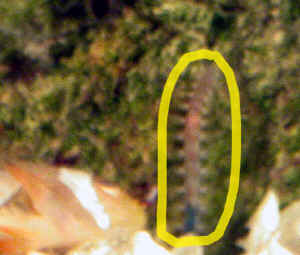|
Bristle/Fireworms System
FAQs
Related FAQs: Worm
Systems, & Bristle/Fireworms
1, Bristle/Fireworms
2, Bristle/Fireworms 3,
Bristle/Fireworms 4,
Worm
Identification, Polychaete Identification, Polychaete Behavior, Polychaete Compatibility, Polychaete Selection, Polychaete Feeding, Polychaete Disease, Polychaete
Reproduction,
Related Articles: Worms,
Polychaetes, Flatworms/Planaria,
|

|
| Amphitrite / Spaghetti Worm Question, sys.
12/10/07 Hello Wet Web Crew, I added a new Amphitrite to my
nano tank 2 days ago. Its body is a healthy red/pink and its
tentacles are active, but I am concerned because it has not
burrowed into the sand. I have buried its posterior half just under
the sand thinking I might give it a start, but it just slowly works
its way back to the surface. As you can see in the attached
pictures I have placed a bit of live rock in front of it. I was
hoping to protect its delicate/exposed body until it burrowed in.
Does it normally take a few days for them to become comfortable
enough burrow into the sand? <Mmm, doesn't live in sand like
this...> Could the type of sand be a problem (Ocean Direct
Aragonite live sand)? Or is this simply a behavior that it is only
capable of in early life? Thank you for your time and help. <The
habitat of these animals is finer mix of much smaller sand
particles and silt... "mud". Bob Fenner> |
|
.JPG)
|
I Think I Have (Bristle) Worms, Eco-Aqualizer Question I
think that I have bristle worms in my tank. <<Not unheard
of.>> My Live rock is loaded with them. <<Ah,
EXCELLENT indicator of husbandry (lack thereof), detritus levels. The
worms are there in large numbers because they have plenty of
food.>> I have taken a picture of one that I caught.
<<Not by hand, I hope. Bristle worms look similar to fire worms,
NOT fun! Both can leave these very fine hairs in your skin, not
entirely unlike some species of cacti. (Yes, I have been stuck, left
little bumps in my finger for YEARS!)>> My question is this, are
they harmful to the tank or should I just leave them in the tank?
<<No, they are not harmful at all. There are those who will
assert that they can eat your Tridacnids, some corals, etc., but they
are misinformed. Bristle worms are specifically detritivores
(detritivores?), they eat dead and rotting stuff. Of course, there are
species that may attack desirable specimens, but these are not an
indicator of tank health/husbandry, and don't usually appear in the
large proportions we see with bristle worms.>> Are they
beneficial and if so how do they benefit the tank?
<<They're quite beneficial, especially if you haven't got
a handle on the detritus, as they will actually help prevent a huge
buildup of nitrate within the system by their consumption. However,
they're not very pretty, I personally don't find them desirable
(not after having been stuck), and would address the husbandry here to
get their numbers down. All such issues are posted here on WWM ad
infinitum.>> I have attached two pictures. <<Good
shots.>> I am also wondering if anyone knows anything about a
product called Molecular Ionization which is an inline Aquarium
ionization device. Their web site is www.ecoaqualizer.com and the
product is Inline aquarium ionization. <<Just reading the
drivel on their site gets my hackles up!>> It is supposed to
clean the water and help prevent disease and algae growth. <<This
product is useless, a waste of time, money, effort. If what they claim
were possible, why are municipal water districts not using it? Go to
reefs.org, search this product, learn what a hoax it is!>> Thank
you, Kathy <<You're welcome, Kathy. Spend your hard-earned on
a good protein skimmer, instead. Stay away from these products that
promise the world based on pseudo-science. Marina>> P.S. A big
hello to Bob Fenner!!! I have not been in this forum for quite a
while.

